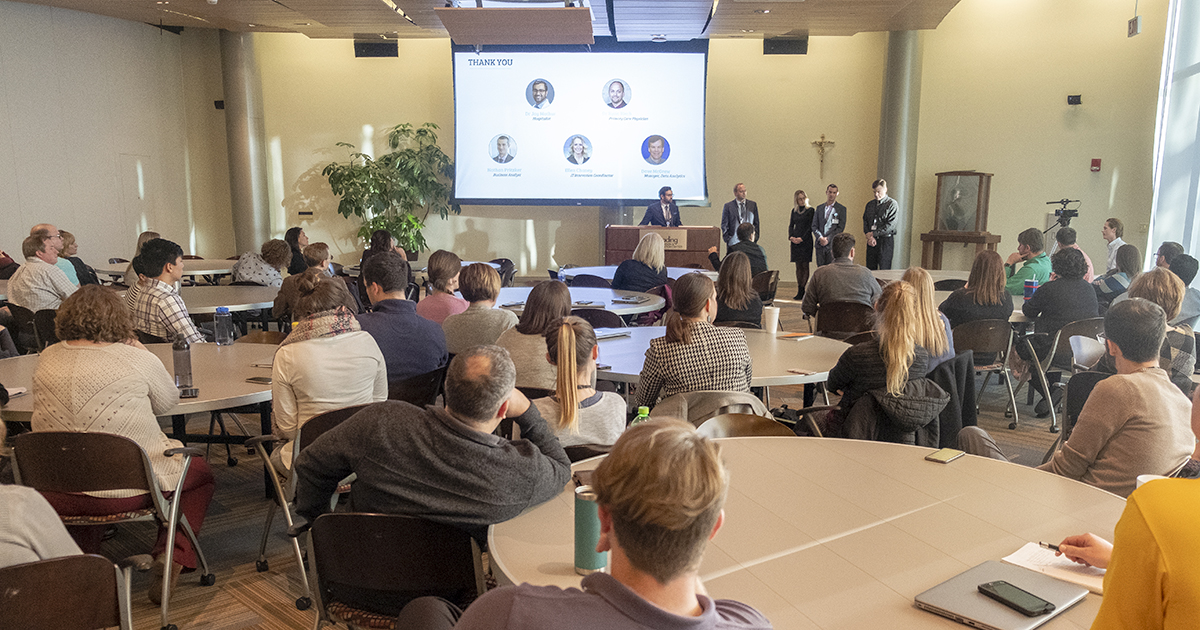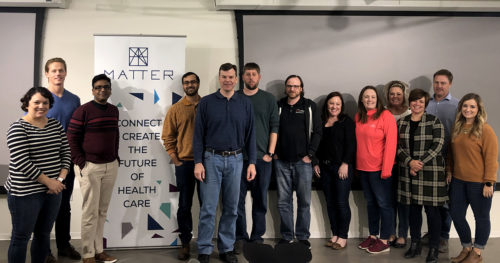
A chance to turn my idea into reality, the finale
Seven weeks. Seven weeks to build out a business idea that could be piloted within OSF HealthCare. Easy peasy lemon squeezy. But first, we needed to gain the tools to make this happen.
Ellen Chaney, Carissa Dodwell and I along with our chosen team members made a trip to MATTER in Chicago during Week 1 to get a crash course in refining our solutions and collecting the information we would need to make final pitches to OSF leadership.
Each of our groups spoke with mentors from MATTER who have experience driving growth in innovative companies, solving issues startups face as they get off the ground and developing health care solutions.
“It was great getting to network with other entrepreneurs,” said Carissa Dodwell. “I enjoyed the different insight from each person we spoke with, as they each brought different ideas to light that we hadn’t thought about.”
That included our mentors asking tough questions about the solutions we were proposing: “Does your app need FDA clearance?” “How are you going to get people to use your solution?” “Is your concept reimbursable?”
I don’t know. I don’t know. And I don’t know. But that was the point of these discussions. Our mentors helped us put together a list of questions we should be answering and challenges we may encounter as we moved forward with our ideas. Then we were set loose to do everything we needed to develop a final proposal.
Seven weeks
 In case you weren’t aware, seven weeks go by pretty fast—especially when you are juggling the creation of health care solutions with doing your real job. Week 1 included the time we spent at MATTER. After that, we had to convene our individual groups to discuss various aspects of our projects at least once a week, dole out responsibilities to members of our teams and come up with pilot designs that could be easily implemented within OSF. Here’s an overview of what the rest of our weeks looked like.
In case you weren’t aware, seven weeks go by pretty fast—especially when you are juggling the creation of health care solutions with doing your real job. Week 1 included the time we spent at MATTER. After that, we had to convene our individual groups to discuss various aspects of our projects at least once a week, dole out responsibilities to members of our teams and come up with pilot designs that could be easily implemented within OSF. Here’s an overview of what the rest of our weeks looked like.
Week 2-3: Conduct interviews to validate your problem and test your solution requirements
In this research phase, we had to interview potential stakeholders and customers on problems they face in meeting certain goals, elements they would like to see in new solutions and whether they would actually use what we were developing. In my group’s case, we sent out surveys to members of the care team at OSF and the public to gauge their interest.
We interviewed the OSF Wellness team to understand their pain points in getting our own Mission Partners healthy and whether the adoption of this new solution could help. We also added a member of the Wellness group to our team for further insight. As part of our research, we learned that hospital employees are more likely to be diagnosed with chronic conditions compared to the regular workforce. This information was supported through our own data collection.
After a lot of discussions, my group determined it would be best to partner with a company that’s already active in the targeted health space. Instead of piloting with the general public, we decided to pitch the idea of testing this solution with our own Mission Partners.
Week 4-5: Refine the solutions and pilot proposal design
During these weeks, we needed to continue building the customer journey with our solutions, identify potential competitors and then further breakdown and understand offerings in this space. With a pivot in our solution, my team interviewed various companies with products targeting at-risk populations. Our goal was to select a platform that could help us reach these individuals and demonstrate results.
Week 6-7: Refine pilot proposal and pitch development
With only a week to go, our teams needed to have a project plan in place with endpoints and decision-making metrics. In talking to my fellow Trailblazer comrades, we all worked up until the very last minute to make this happen. My team was still interviewing companies the day before we gave our final pitches.
Our plan was to adopt a solution that was easy to use, integrated into the electronic medical record, included health coaches and incentives and could reduce costs for our Mission Partners. The solution would be piloted with 100 people from across the Ministry over the period of a year.
Baseline information would be collected before kick-off. We would use data to determine whether our chosen solution was successful. If so, we would ask to scale across the organization and eventually to patients.
Final pitch day
Seven weeks and we were done! Our groups made our final pitches to a room full of Mission Partners. We each got 10 minutes to present with another five minutes left for questions. Everyone’s presentations were fantastic. I’m so proud of the work we were all able to achieve in such a short amount of time. My colleagues feel the same way.
“From my perspective, this challenge was a great learning, collaborative and exciting experience,” said Ellen Chaney. “I really look forward to what these challenges will bring for the future of OSF HealthCare.”
As for what’s next, we’ve all been invited to continue developing pilot plans with internal stakeholders within OSF. So, our work is not over and I’d venture to say the fun has just begun.